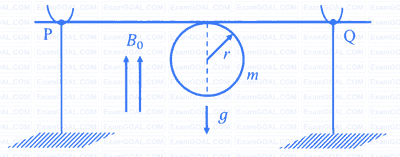
A thin stiff insulated metal wire is bent into a circular loop with its two ends extending tangentially from the same point of the loop. The wire loop has mass $m$ and radius $r$ and it is in a uniform vertical magnetic field $B_0$, as shown in the figure. Initially, it hangs vertically downwards, because of acceleration due to gravity $g$, on two conducting supports at $\mathrm{P}$ and $\mathrm{Q}$. When a current $I$ is passed through the loop, the loop turns about the line $\mathrm{PQ}$ by an angle $\theta$ given by


An infinitely long wire, located on the $z$-axis, carries a current $I$ along the $+z$-direction and produces the magnetic field $\vec{B}$. The magnitude of the line integral $\int \vec{B} \cdot \overrightarrow{d l}$ along a straight line from the point $(-\sqrt{3} a, a, 0)$ to $(a, a, 0)$ is given by
[ $\mu_0$ is the magnetic permeability of free space.]

Which one of the following options represents the magnetic field $\vec{B}$ at $\mathrm{O}$ due to the current flowing in the given wire segments lying on the $x y$ plane?


A small circular loop of area $A$ and resistance $R$ is fixed on a horizontal $x y$-plane with the center of the loop always on the axis $\hat{n}$ of a long solenoid. The solenoid has $m$ turns per unit length and carries current $I$ counterclockwise as shown in the figure. The magnetic field due to the solenoid is in $\hat{n}$ direction. List-I gives time dependences of $\hat{n}$ in terms of a constant angular frequency $\omega$. List-II gives the torques experienced by the circular loop at time $t=\frac{\pi}{6 \omega}$. Let $\alpha=\frac{A^{2} \mu_{0}^{2} m^{2} I^{2} \omega}{2 R}$.

| List-I | List-II |
|---|---|
| (I) $\frac{1}{\sqrt{2}}(\sin \omega t \hat{\jmath}+\cos \omega t \hat{k})$ | (P) 0 |
| (II) $\frac{1}{\sqrt{2}}(\sin \omega t \hat{\imath}+\cos \omega t \hat{\jmath})$ | (Q) $-\frac{\alpha}{4} \hat{\imath}$ |
| (III) $\frac{1}{\sqrt{2}}(\sin \omega t \hat{\imath}+\cos \omega t \hat{k})$ | (R) $\frac{3 \alpha}{4} \hat{\imath}$ |
| (IV) $\frac{1}{\sqrt{2}}(\cos \omega t \hat{\jmath}+\sin \omega t \hat{k})$ | (S) $\frac{\alpha}{4} \hat{\jmath}$ |
| (T) $-\frac{3 \alpha}{4} \hat{\imath}$ |
Which one of the following options is correct?